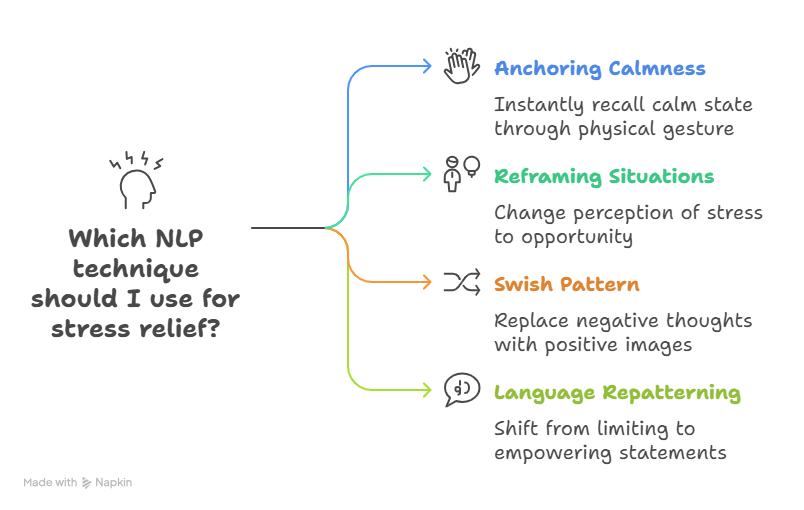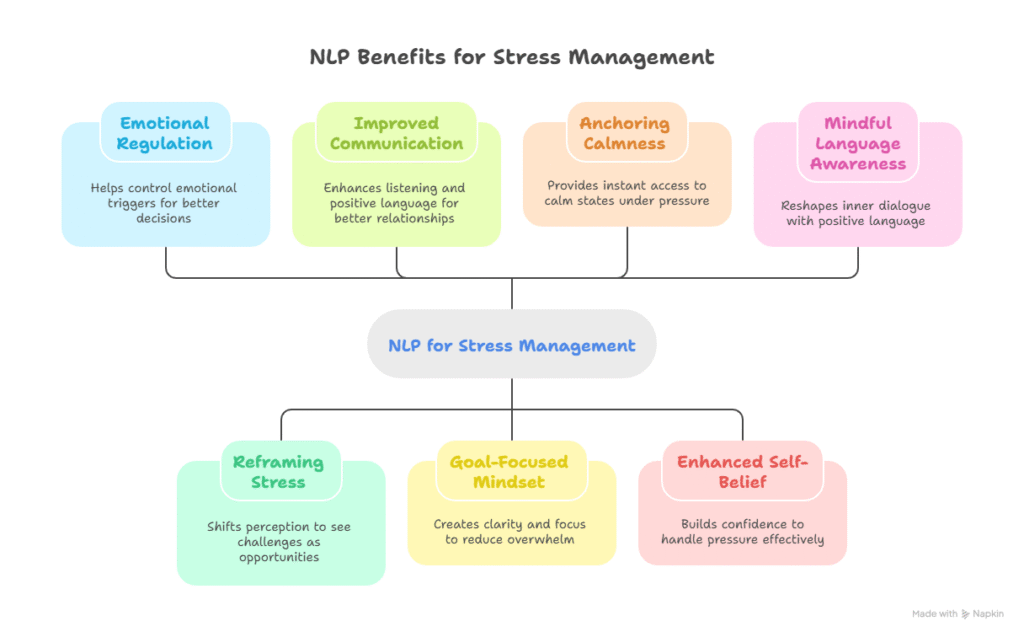Stress management through Neuro-Linguistic Programming (NLP) helps professionals manage business stress by reshaping how they think and respond under pressure. Using techniques like anchoring calmness, reframing challenges, and visualizing success, NLP transforms anxiety into focus and tension into confidence.
When practiced daily and combined with habits like exercise, mindful breathing, and good sleep, it builds emotional resilience and sharper decision-making. For entrepreneurs and leaders, NLP turns stress from an obstacle into a tool for clarity, performance, and growth.
Introduction
In today’s fast-paced business world, stress isn’t just common; it’s constant. Whether it’s handling deadlines, managing employees, or making high-stakes decisions, entrepreneurs and professionals alike face daily pressure that can drain energy and focus. Traditional stress relief methods often provide temporary calm, but Neuro-Linguistic Programming (NLP) offers something deeper, a way to retrain your mind to respond differently to stress itself.
NLP (Neuro-Linguistic Programming) helps you understand how thoughts, language, and behavior interact. It equips business leaders to reframe stress, build emotional resilience, and enhance mental clarity so they can perform under pressure without burning out.
Let’s explore how NLP techniques can transform how you handle workplace stress and build a calmer, stronger mindset for success.
Key Takeaways
- NLP helps regulate emotions and reframe stressful events for better control.
- Techniques like anchoring, reframing, and visualization reduce stress in real time.
- By mastering internal dialogue, professionals can prevent burnout and boost focus.
- NLP turns pressure into productivity by rewiring thought patterns.
- Regular NLP practice builds long-term emotional resilience in business settings
Understanding Stress in Business

Workplace stress comes from deadlines, competition, uncertainty, and people management. It often manifests as anxiety, irritability, or decision fatigue.
NLP reframes stress as feedback, not failure, helping you decode what your mind and body are communicating. For example, instead of viewing a stressful presentation as a threat, NLP helps you see it as an opportunity for growth and influence.
NLP teaches that stress is not what happens to you; it’s how your mind represents it.
How NLP Works for Stress Management
NLP is based on the idea that thoughts create emotional states, which drive behavior. When you change the mental representation of an event, your emotional response changes too.
Core Mechanisms:
- Reprogramming thought patterns: NLP helps replace negative or catastrophic thinking with empowering interpretations.
- Language awareness: Changing the words you use (“I’m overwhelmed” → “I’m challenged and capable”) alters emotional impact.
- Anchoring calmness: NLP trains the brain to trigger relaxation through specific cues.
This shift allows leaders to maintain focus and composure even in high-pressure environments.
NLP Techniques for Stress Relief in Business
Stress in business is inevitable but how you respond to it determines whether it controls you or fuels your growth. NLP provides powerful tools to retrain your brain, helping you stay calm, focused, and emotionally balanced even under intense pressure. Here are four core techniques you can start applying immediately:
A. Anchoring Calmness
Anchoring is one of the most practical NLP tools for instant stress relief. It works by linking a specific physical gesture (like touching your fingers together) with a desired emotional state, such as calmness or confidence.
How to Practice Anchoring:
- Find a quiet moment and close your eyes.
- Recall a time when you felt completely relaxed, confident, and in control.
- Fully immerse yourself in that memory, feel the sensations, hear the sounds, visualize the environment.
- As the emotion intensifies, press your thumb and forefinger together.
- Release and repeat several times, reinforcing the connection between the gesture and calmness.
How to Use It:
Before a big presentation, investor pitch, or stressful negotiation, perform your anchor gesture. Within seconds, your mind will recall the calm state you linked earlier, helping you respond with clarity instead of anxiety.
B. Reframing Stressful Situations
Reframing is a core NLP strategy that changes how you interpret challenges. Instead of perceiving stress as a threat, you view it as a learning opportunity or growth signal. This shift can completely transform your mental and emotional state.
Example of Reframing:
- Before NLP: “This project is too much to handle.”
- After NLP: “This project is an opportunity to strengthen my leadership and time management skills.”
By changing your internal language, you change your emotional experience. Reframing helps you move from reacting emotionally to responding strategically, turning obstacles into fuel for progress.

C. Swish Pattern for Overthinking
When your mind spirals with negative thoughts like replaying a failed meeting or imagining worst-case scenarios, the Swish Pattern helps break that cycle. It reprograms the subconscious to replace stressful mental images with confident, empowering ones.
How to Do It:
- Visualize the stressful image (for example, you fumbling during a presentation)
- Create a second image of yourself succeeding, confident, smiling, and in control.
- Mentally “swish” the two images: make the negative one fade quickly while the positive one becomes vivid, bright, and close
- Repeat 5–10 times until your brain automatically focuses on the confident image.
This process helps train your subconscious to expect success rather than fear failure.
D. Language Repatterning
The words you use internally and externally shape how you experience stress. NLP encourages language repatterning, or replacing limiting, fear-based statements with empowering, choice-driven ones.
Examples:
- “I have to meet this deadline.” → “I choose to complete this project to the best of my ability.
- “This situation is impossible.” → “This situation is challenging, but I can find a solution.”
- “I’m under pressure” → “I’m being stretched to grow.
When you consciously shift your language, you shift your mindset. Over time, this reduces the emotional weight of stressful events and increases your sense of control.
Benefits of Using NLP for Stress Management in Business
Applying NLP techniques consistently in your professional life can create lasting improvements in both mindset and performance. By reprogramming thought patterns and emotional responses, NLP helps entrepreneurs, leaders, and professionals handle stress with clarity, composure, and confidence.
Below are the key benefits of using NLP for stress management in business:

Emotional Regulation → Better Leadership Decisions
NLP helps you recognize and control emotional triggers, allowing you to stay calm during conflicts, deadlines, or high-stakes negotiations.
Benefit: Leaders who regulate emotions make clearer, more strategic decisions without being influenced by anxiety or frustration.
Reframing Stress → Boosts Creativity & Problem-Solving
By shifting your perception of challenges from “stressful obstacles” to “growth opportunities,” you free your mind to think more creatively.
Benefit: This mindset turns pressure into productive energy and helps you find innovative solutions faster.
Improved Communication → Stronger Workplace Relationships
NLP enhances your ability to listen actively, mirror others’ communication styles, and use positive language.
Benefit: Builds deeper trust and understanding with clients, colleagues, and teams, reducing workplace tension and misunderstandings.
Goal-Focused Mindset → Less Overwhelm & Procrastination
Through NLP goal-setting and visualization techniques, you create mental clarity about what truly matters.
Benefit: You stay organized, focused, and motivated, which minimizes stress caused by confusion or lack of direction.
Anchoring Calmness → Confidence Under Pressure
Anchoring allows you to access calm, confident states instantly, even during presentations, negotiations, or decision-making moments.
Benefit: You perform with greater composure and self-assurance, regardless of external chaos or business stressors.
Enhanced Self-Belief → Long-Term Stress Resilience
NLP helps replace limiting beliefs (“I can’t handle this”) with empowering affirmations (“I adapt and thrive under pressure”).
Benefit: Builds lasting confidence, reducing the emotional burden of failure and uncertainty in business.
Mindful Language Awareness → Positive Mental Framing
By consciously choosing empowering language, you reshape your inner dialogue.
Benefit: Reduces negative self-talk and anxiety, helping you maintain a solution-focused attitude even in challenging situations.
Combining NLP with Other Stress Management Strategies

While NLP effectively trains the mind to handle stress, combining it with supportive lifestyle habits creates deeper, more lasting balance. Together, these approaches strengthen emotional resilience, mental clarity, and overall performance in business.
Physical Activity – Release and Renew
Regular exercise boosts endorphins and lowers cortisol, helping you feel more energized and positive.
NLP connection: Physical movement reinforces mental flexibility and anchors positive emotional states, improving focus and calm under pressure.
Mindful Breathing – Stay Centered
Slow, intentional breathing keeps the mind grounded and reduces tension.
NLP connection: Pairing mindful breathing with NLP anchoring enhances your ability to trigger calm before stressful meetings or presentations.
Healthy Nutrition – Feed Your Mind
Balanced meals rich in omega-3s, magnesium, and antioxidants support emotional stability and brain function.
NLP connection: A nourished brain strengthens your capacity to apply NLP techniques effectively and maintain steady emotions.
Sleep Hygiene – Recharge and Restore
Consistent, quality sleep improves focus, decision-making, and emotional control.
NLP connection: NLP visualization before bed can help calm racing thoughts and promote deep rest, preparing you for a productive day ahead.
The Integrative Effect
When NLP is practiced alongside physical, mindful, and restorative habits, it transforms stress management into a holistic system.
Result: Greater resilience, productivity, and long-term mental balance in business.
Conclusion
Neuro-Linguistic Programming (NLP) is more than a stress management tool; it’s a mindset transformation system that helps professionals stay calm, focused, and effective under pressure. In business, where challenges are constant, NLP enables leaders to reframe stress into clarity and anxiety into confident action.
By applying techniques like anchoring, reframing, and visualization, professionals can manage emotions, think strategically, and maintain balance even during demanding situations. NLP strengthens emotional intelligence, enhances communication, and nurtures resiliency, key traits for long-term success.
In short, stress in business is unavoidable but with NLP, it becomes manageable and even empowering. It turns daily pressure into purpose, helping you lead with calm confidence and consistent clarity.
FAQs
Can NLP permanently eliminate stress?
Not entirely. NLP doesn’t erase stress but helps you control how you respond to it, turning pressure into productivity.
Which NLP technique works best for stress?
Anchoring and reframing are the most effective they help regulate emotions quickly and reframe negative situations.
How often should I practice NLP for stress relief?
Daily short sessions (5–10 minutes) of visualization, anchoring, or positive self-talk build lasting results.
Can NLP be combined with meditation or mindfulness?
Absolutely. NLP enhances mindfulness by making your awareness more intentional and solution-oriented.
Who can benefit from NLP stress management?
Entrepreneurs, managers, and professionals in high-pressure environments who want better emotional control and focus.





